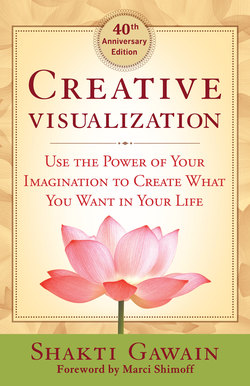Читать книгу Creative Visualization - Shakti Gawain - Страница 14
ОглавлениеHOW CREATIVE VISUALIZATION WORKS
In order to understand how creative visualization works, it’s useful to look at several interrelated principles:
The Physical Universe Is Energy
The scientific world is beginning to discover what metaphysical and spiritual teachers have known for centuries. Our physical universe is not really composed of any “matter” at all; its basic component is a kind of force or essence that we call energy.
Things appear to be solid and separate from one another on the level at which our physical senses normally perceive them. On finer levels, however, atomic and subatomic levels, seemingly solid matter is seen as smaller and smaller particles within particles, which eventually turn out to be just pure energy.
Physically, we are all energy, and everything within and around us is made up of energy. We are all part of one great energy field. Things that we perceive to be solid and separate are in reality just various forms of our essential energy which is common to all. We are all one, even in a literal, physical sense.
The energy is vibrating at different rates of speed, and thus has different qualities, from finer to denser. Thought is a relatively fine, light form of energy and, therefore, very quick and easy to change. Matter is relatively dense, compact energy, and therefore slower to move and change. Within matter there is great variation as well. Living flesh is relatively fine, changes quickly, and is easily affected by many things. A rock is a much denser form, slower to change, and more difficult to affect. Yet even rock is eventually changed and affected by the fine, light energy of water, for example. All forms of energy are interrelated and can affect one another.
Energy Is Magnetic
One law of energy is this: Energy of a certain quality or vibration tends to attract energy of a similar quality and vibration.
Thoughts and feelings have their own magnetic energy that attracts energy of a similar nature. We can see this principle at work, for instance, when we “accidentally” run into someone we’ve just been thinking of, or “happen” to pick up a book that contains exactly the perfect information we need at that moment.
Form Follows Idea
Thought is a quick, light, mobile form of energy. It manifests instantaneously, unlike the denser forms such as matter.
When we create something, we always create it first in thought form. A thought or idea always precedes manifestation. “I think I’ll make dinner” is the idea that precedes creation of a meal. “I want a new dress” precedes going and buying one; “I need a job” precedes finding one, and so on.
An artist first has an idea or inspiration, then creates a painting. A builder first has a design, then builds a house.
The idea is like a blueprint; it creates an image of the form, which then magnetizes and guides the physical energy to flow into that form, and eventually manifests it on the physical plane.
The same principle holds true even if we do not take direct physical action to manifest our ideas. Simply having an idea or thought, holding it in your mind, is an energy that will tend to attract and create that form on the material plane. If you constantly think of illness, you may eventually become ill; if you believe yourself to be beautiful, you become so. Unconscious ideas and feelings held inside of us operate in the same way.
The Law of Radiation and Attraction
This is the principle that whatever you put out into the universe will be reflected back to you. “As you sow, so shall you reap.”
What this means from a practical standpoint is that we always attract into our lives whatever we think about the most, believe in most strongly, expect on the deepest levels, and/or imagine most vividly.
When we are negative and fearful, insecure or anxious, we often attract the very experiences, situations, or people that we are seeking to avoid. If we are basically positive in attitude, expecting and envisioning pleasure, satisfaction, and happiness, we tend to attract and create people, situations, and events that conform to our positive expectations. So, consciously imagining what we want can help us to manifest it in our lives.
Using Creative Visualization
The process of change does not occur on superficial levels, through mere “positive thinking.” It involves exploring, discovering, and changing our deepest, most basic attitudes toward life. That is why learning to use creative visualization can become an experience of deep and meaningful growth. In the process we often discover ways in which we have been holding ourselves back, blocking ourselves from achieving satisfaction and fulfillment in our lives through our fears and unconscious beliefs. Once seen clearly, these limiting attitudes can often be dissolved through the creative visualization process, leaving space for us to find and live a natural state of greater happiness, fulfillment, and love. . . .
At first you may practice creative visualization at specific times and for specific goals. As you get more in the habit of using it, and begin to trust the results it can bring you, you will find that it becomes an integral part of your thinking process. It becomes a continuous awareness, a state of consciousness in which you know that you are the constant creator of your life.
That is the ultimate point of creative visualization — to make every moment of our lives a moment of wondrous creation, in which we are just naturally choosing the best, the most beautiful, the most fulfilling lives we can imagine. . . .
